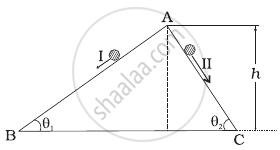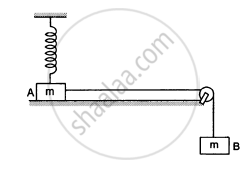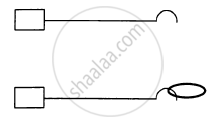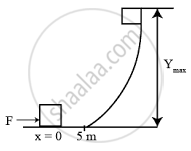Advertisements
Advertisements
प्रश्न
Two inclined frictionless tracks, one gradual and the other steep meet at A from where two stones are allowed to slide down from rest, one on each track as shown in figure.

Which of the following statement is correct?
विकल्प
Both the stones reach the bottom at the same time but not with the same speed.
Both the stones reach the bottom with the same speed and stone I reaches the bottom earlier than stone II.
Both the stones reach the bottom with the same speed and stone II reaches the bottom earlier than stone I.
Both the stones reach the bottom at different times and with different speeds.
उत्तर
Both the stones reach the bottom with the same speed and stone II reaches the bottom earlier than stone I.
Explanation:
As seen in the diagrams, AB and AC are two smooth planes inclined at the angles θ1 and θ2, respectively.
Because there is no friction here, mechanical energy will be preserved.
Because both tracks have the same height h,
`1/2 mv^2 = mg`
`hv = sqrt(2gh)`
Hence, speed is the same for both stones. For stone I, a1 = acceleration along the inclined plane = g sin θ1
Similarly, for stone II, a2 = g sin θ2
And because track II is shorter in length, stone II arrives earlier than stone I.
APPEARS IN
संबंधित प्रश्न
A person trying to lose weight (dieter) lifts a 10 kg mass, one thousand times, to a height of 0.5 m each time. Assume that the potential energy lost each time she lowers the mass is dissipated.
- How much work does she do against the gravitational force?
- Fat supplies 3.8 x 107J of energy per kilogram which is converted to mechanical energy with a 20% efficiency rate. How much fat will the dieter use up?
A heavy stone is thrown in from a cliff of height h in a given direction. The speed with which it hits the ground
(a) must depend on the speed of projection
(b) must be larger than the speed of projection
(c) must be independent of the speed of projection
(d) may be smaller than the speed of projection.
Figure shows a particle sliding on a frictionless track which terminates in a straight horizontal section. If the particle starts slipping from point A, how far away from the track will the particle hit the ground?

In the following figure shows two blocks A and B, each of mass of 320 g connected by a light string passing over a smooth light pulley. The horizontal surface on which the block Acan slide is smooth. Block A is attached to a spring of spring constant 40 N/m whose other end is fixed to a support 40 cm above the horizontal surface. Initially, the spring is vertical and unstretched when the system is released to move. Find the velocity of the block A at the instant it breaks off the surface below it. Take g = 10 m/s2.

Figure following shows a light rod of length l rigidly attached to a small heavy block at one end and a hook at the other end. The system is released from rest with the rod in a horizontal position. There is a fixed smooth ring at a depth h below the initial position of the hook and the hook gets into the ring as it reaches there. What should be the minimum value of h so that the block moves in a complete circle about the ring?

A particle is released from height S from the surface of the Earth. At a certain height, its kinetic energy is three times its potential energy. The height from the surface of the earth and the speed of the particle at that instant are respectively ______.
In a shotput event an athlete throws the shotput of mass 10 kg with an initial speed of 1 ms–1 at 45° from a height 1.5 m above ground. Assuming air resistance to be negligible and acceleration due to gravity to be 10 ms–2, the kinetic energy of the shotput when it just reaches the ground will be ______.
A body falls towards earth in air. Will its total mechanical energy be conserved during the fall? Justify.
A single conservative force acts on a body of mass 1 kg that moves along the x-axis. The potential energy U(x) is given by U (x) = 20 + (x - 2)2, where x is in meters. At x = 5.0 m the particle has a kinetic energy of 20 J, then the maximum kinetic energy of body is ______ J.
A force shown in the F-x graph is applied to a 5 kg cart, which then coasts up a ramp as shown. The maximum height, ymax is ______ m, at which the cart can reach.
(g = 10 m/s2)


